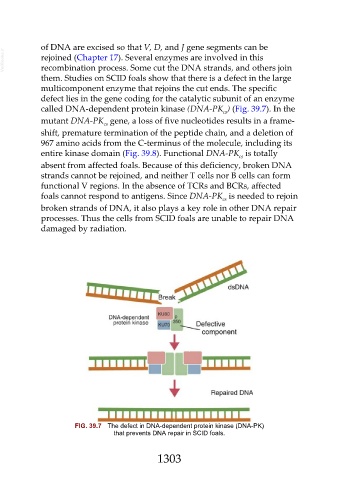Page 1303 - Veterinary Immunology, 10th Edition
P. 1303
of DNA are excised so that V, D, and J gene segments can be
VetBooks.ir rejoined (Chapter 17). Several enzymes are involved in this
recombination process. Some cut the DNA strands, and others join
them. Studies on SCID foals show that there is a defect in the large
multicomponent enzyme that rejoins the cut ends. The specific
defect lies in the gene coding for the catalytic subunit of an enzyme
called DNA-dependent protein kinase (DNA-PK ) (Fig. 39.7). In the
cs
mutant DNA-PK gene, a loss of five nucleotides results in a frame-
cs
shift, premature termination of the peptide chain, and a deletion of
967 amino acids from the C-terminus of the molecule, including its
entire kinase domain (Fig. 39.8). Functional DNA-PK is totally
cs
absent from affected foals. Because of this deficiency, broken DNA
strands cannot be rejoined, and neither T cells nor B cells can form
functional V regions. In the absence of TCRs and BCRs, affected
foals cannot respond to antigens. Since DNA-PK is needed to rejoin
cs
broken strands of DNA, it also plays a key role in other DNA repair
processes. Thus the cells from SCID foals are unable to repair DNA
damaged by radiation.
FIG. 39.7 The defect in DNA-dependent protein kinase (DNA-PK)
that prevents DNA repair in SCID foals.
1303

